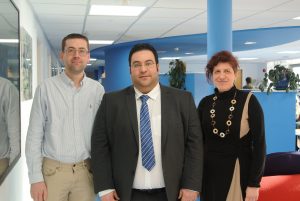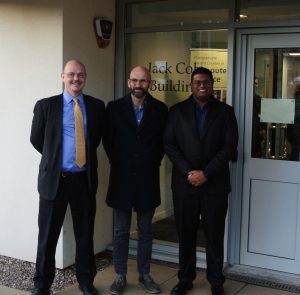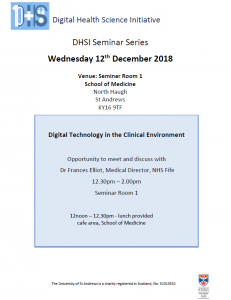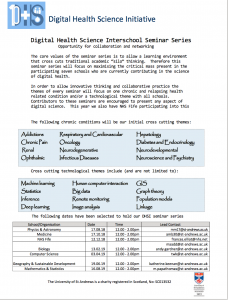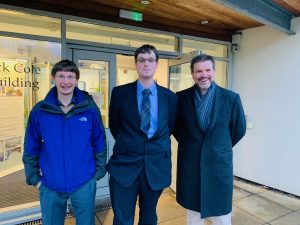Congratulations to Hussein Bakri, who successfully defended his thesis today. He is pictured with Internal examiner Professor Ian Miguel and external examiner Dr Maria Economou, from the University of Glasgow.
Research
Dr Juan Ye: Lifelong Learning in Human Activity Recognition
Dr Juan Ye will be running an online event for IEEE SMC (Systems, Man and Cybernetics Society) on Lifelong Learning. The technical seminar, designed to focus on future research trends in human activity recognition, will take place on Friday 1st February from 2.00pm – 3.00pm.
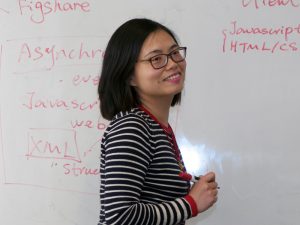
Seminar Details: Human activity recognition systems will be increasingly deployed in real-world environments and for longer periods of time. This significantly challenges current approaches to human activity recognition, which have to account for changes in activity routines, evolution of situations, and of sensing technologies. Driven by these challenges, this webinar will argue the need to move beyond learning to lifelong machine learning – with the ability to incrementally and continuously adapt to changes in the environment being learned. We will introduce a conceptual framework for lifelong machine learning to structure various relevant proposals in the area, and identify some key research challenges that remain.
Read more about the event and joining instructions through IEEE online.
Tom Kelsey appointed Associate Editor of Human Reproduction Update
Arne Sunde, the incoming Editor-in-Chief, has appointed Tom Kelsey as Associate Editor of Human Reproduction Update.
Human Reproduction Update is the leading journal in Reproductive Medicine, with an Impact Factor of 11.852. The journal publishes comprehensive and systematic review articles in human reproductive physiology and medicine, and is published on behalf of the European Society of Human Reproduction and Embryology (ESHRE). The Associate Editor system at Human Reproduction Update has been in place since the beginning of 2001 and it has a significant positive effect on the quality and dynamism of the journal.
In the ISI JCR Global Ranking for 2017, Human Reproduction Update is ranked first of 29 journals in Reproductive Biology, and first of 82 journals in Obstetrics & Gynecology.
Tom Kelsey has published extensively in Human Reproduction Update and its sister journals Human Reproduction (impact factor 4.949) and Molecular Human Reproduction (impact factor 3.449). He is also Associate Editor for the Open Access journals Frontiers in Endocrinology and Frontiers in Physiology. He is a regular reviewer for these journals and also the British Medical Journal, BMJ Open, Health Education Journal, Nature Scientific Reports, PLOS One, Mathematical Medicine and Biology, Systems Biology in Reproductive Medicine, and the European Journal of Obstetrics & Gynecology and Reproductive Biology.
Job vacancies: Lecturers in Computer Science
The School of Computer Science is recruiting two new Lecturers as part of a large on-going expansion of our academic staff.
You will be a scholar with a growing international research reputation in Computer Science and a commitment to delivering high quality teaching within the broad field of Computer Science and its applications. The successful candidate will be expected to have a range of interests, to be active in research publication that strengthens or complements those in the School and to be capable of teaching the subject to undergraduate and taught postgraduate students who come to us with a wide range of backgrounds.
Candidates should hold a PhD in a cognate discipline. Excellent teaching skills and an interest in promoting knowledge exchange are essential. You should also have some familiarity with grant seeking processes in relation to research councils and other sources.
Closing date: 14th January 2019
Informal enquiries can be directed to Professor Simon Dobson (hos-cs@st-andrews.ac.uk) or Dr Dharini Balasubramaniam (dot-cs@st-andrews.ac.uk).
Find out more about the vacancies further particulars on the recruitment website.
Professors Quigley and Kitamura to co-chair ACM CHI 2021 in Asia

Professors Quigley and Kitamura
Professor Aaron Quigley and Professor Yoshifumi Kitamura (Tohoku University, Japan) have been appointed the general co-chairs for the ACM CHI conference on Human Factors in Computing Systems in Asia in 2021. CHI is hosted by the ACM SIGCHI, the Special Interest Group on Computer-Human Interaction
The ACM CHI Conference on Human Factors in Computing Systems is the premier international conference for the field of Human-Computer Interaction (HCI). This flagship conference is generally considered the most prestigious in the field of HCI and attracts thousands of international attendees annually.
 CHI provides a place where researchers and practitioners can gather from across the world to discuss the latest HCI topics. It has been held since 1982 and this is only the second time CHI will be held in Asia. CHI 2020 will be held in Hawaii while CHI 2019 will be held in Glasgow next May. The location for CHI 2021 will be announced to the global research community during CHI 2019.
CHI provides a place where researchers and practitioners can gather from across the world to discuss the latest HCI topics. It has been held since 1982 and this is only the second time CHI will be held in Asia. CHI 2020 will be held in Hawaii while CHI 2019 will be held in Glasgow next May. The location for CHI 2021 will be announced to the global research community during CHI 2019.
 This week Professor Quigley was invited to present at the Third ACM SIGCHI Asian Symposium hosted in the Research Institute of Electrical Communication at Tohoku University, Sendai. The ACM SIGCHI Asian Development committee organised this event to bring together early career researchers, students and more from multiple countries in the Asia-Pacific region to discuss ideas that can lead to innovations and to inspire us all. The event served to develop connections and regional/local societies through promoting collaboration among Asian-Pacific HCI researchers and practitioners. Professor Quigley will be spending his upcoming sabbatical in Asia.
This week Professor Quigley was invited to present at the Third ACM SIGCHI Asian Symposium hosted in the Research Institute of Electrical Communication at Tohoku University, Sendai. The ACM SIGCHI Asian Development committee organised this event to bring together early career researchers, students and more from multiple countries in the Asia-Pacific region to discuss ideas that can lead to innovations and to inspire us all. The event served to develop connections and regional/local societies through promoting collaboration among Asian-Pacific HCI researchers and practitioners. Professor Quigley will be spending his upcoming sabbatical in Asia.
Job vacancies: Interdisciplinary Data Scientists
The Schools of Medicine and Computer Science are seeking to appoint three highly motivated data scientists with a passion for computer vision and deep learning, and specifically their application to medical imaging. The data scientists will be based in the Schools of Computer Science and Medicine at the University of St Andrews and will work on a national Innovate UK funded initiative to create a pan Scotland Industrial Centre for AI Research in Digital Diagnostics (iCAIRD).
The successful candidates will have the opportunity to work alongside and learn from clinicians, industrial experts from Philips Healthcare and academics to help develop artificial intelligence solutions for the automatic reporting of cancer diagnoses in endometrial and cervical cancer. The main duties of the role will involve being an active member of an interdisciplinary team of scientists to help develop deep learning algorithms, within industry standard guidelines, to analyse patient samples in a manner that allows rapid clinical transfer. This work will therefore have the opportunity to impact both patient welfare and relieve pathologist work burden.
Applicants should have experience in machine learning, demonstrable experience in computer programming languages and an interest in the medical applications of computer science. The candidates would benefit from a track record in scientific writing and working in interdisciplinary teams as well as experience in computer vision.
The posts are full time and over a period of 36 months.
Closing Date: 18 January 2019
Find out more about the vacancies further particulars on the recruitment website.
PhD viva success: Khawar Shehzad
Congratulations to Khawar Shehzad, who successfully defended his thesis today. He is pictured with supervisor Professor Saleem Bhatti, Internal examiner Dr Ishbel Duncan and external examiner Dr Dimitrios Pezaros, from the University of Glasgow.
PhD viva success: Shyam Reyal
Congratulations to Shyam Reyal, who successfully defended his thesis yesterday. He is pictured with Internal examiner Dr Tom Kelsey and external examiner Dr Mark Dunlop , from the University of Strathclyde. Shyam’s research was supervised by Dr Per Ola Kristensson and Dr Mark-Jan Nederhof.
Image courtesy of Annemarie Paton
DHSI Seminar: Wednesday 12th December
PhD viva success: Julian Petford
Congratulations to Julian Petford, who successfully defended his thesis today. He is pictured with internal examiner Professor Aaron Quigley and external examiner Dr Jason Alexander, from Lancaster University. Julian’s PhD research in Full Coverage Displays for Non-Immersive Applications was supervised by Dr Miguel Nacenta.
Image courtesy of Wendy Boyter


